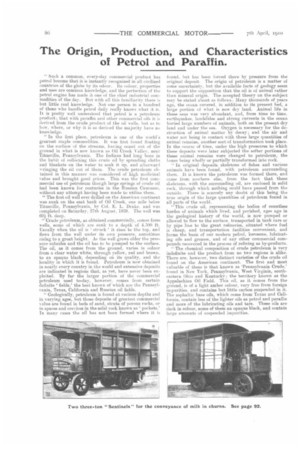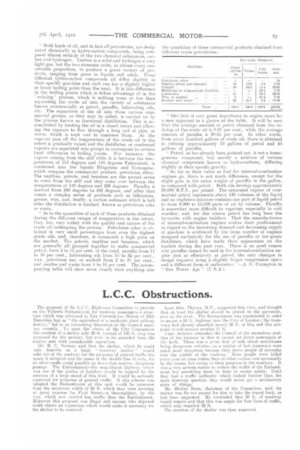The Origin, Production, and Characteristics of Petrol and Paraffin.
Page 6

Page 7

If you've noticed an error in this article please click here to report it so we can fix it.
" Such a common, every-day commercial product has petrol become that it is instantly recognized in all civilized countries of the globe by its odour. its colour, properties and uses are common knowledge, and the perfection of the petrol engine has made it one of the chief industrial commodities of the day. But with all this familiarity there is but little real knowledge. Not one person in a hundred of those who handle petrol daily really knows what it is. It is pretty well understood that petrol is a petroleum product; that with paraffin and other commercial oils it is derived from the crude product of the oil wells. but as to how, where, or why it is so derived the majority have no knowledge.
"In the first place, petroleum is one of the world's greatest staple commodities. It was first found floating on the surface of the streams, having oozed out of the ground in what is now known as Oil Creek Valley, near Titusville, Pennsylvania. The Indians had long been in the habit of collecting this crude oil by spreading cloths and blankets on the water to soak it up, and afterward wringing the oil out of them. The crude petroleum obtaMed in this manner was considered of high medicinal value and brought good prices. This was the first commercial use of petroleum though large springs of crude oil had been known for centuries in the Russian Caucasus, without any attempt having been made to utilize them. "The first oil well ever drilled on the American continent was sunk on the east bank of Oil Creek, one mile below Titusville, Pennsylvania, hr Col. E. L. Drake. and was completed on Saturday, 2;th August. 1859. The well was 69-i ft. deep.
"Crude petroleum, as obtained commercially, comes from wells, sonic of which are sunk to a depth of 4.500 ft. Usually when the oil is struck ' it rises to the top, and flows from the well under its own pressure, sometimes rising to a great height. As the well grows older the pressure subsides and the oil has to be pumped to the surface. The oil, as it comes from the ground, varies in colour from a clear water white, through yellow, red and brown, to an opaque black, depending an its quality, and the locality in which it is found. Petroleum is now obtained in nearly every country in the world and extensive deposits are indicated in regions that, as yet, have never been exploited. By far the larger portion of the commercial petroleum used to-day, however, comes from certain definite fields,' the best known of which are the Pennsylvania, Texas, California and Russian oil fields.
" Geologically, petroleum is found at various depths and in varying ages, but those deposits of greatest commercial value are found in beds of sand, strata of porous rocks, or in spaces and crevices in the solid rock known as 'pockets.' In many eases the oil has not been formed where it is
found, but has been forced there by pressure from the original deposit. The origin of petroleum is a matter of some uncertainty, but the available facts of geology seem to support. the supposition that the oil is of animal rather than mineral origin. The accepted theory on the subject may he stated about as follows: Many thousands of years ago, the ocean covered, in addition to its present bed, a large portion of what is now dry land. Animal life in these seas was very abundant, and, from time to time, earthquakes, landslides and strong currents in the ocean buried large numbers of animals, both on the present dry land and under the sea.. Oxygen is necessary for the destruction of animal matter by decay; and the air and water not being in contact with these large quantities of animal remains, another sort of transformation took place. In the course of time, under the high pressures to which these deposits were later subjected the softer portions of these animal remains were changed to petroleum, the bones being wholly or partially transformed into rock.
" In original deposits skeletons of fishes and various animals have been found, with petroleum surrounding theni. It is known the petroleum was formed there, and came from nowhere else, from the fact that these skeletons, with the surrounding oil, are enclosed in solid rock, through which nothing could have passed from the outside. There is scarcely any doubt of this being the true origin of the large quantities of petroleum found in all parts of the world,
"This crude oil, representing the bodies of countless hordes of animals which lived, and perished, ages ago in the geological history of the world, is now pumped or allowed to flow to the surface, transported in tank ears or by pipe line to the great refineries, situated where fuel is cheap, and transportation facilities convenient, and forms the basis of our modern petrol, kerosene, lubricating oils and greases, and of any other commercial compounds recovered in the process of refining as by-products. " The chemical composition of crude petroleum is very indefinite and the product from no two regions is alike. There are, however, two distinct varieties of the crude oil found on the American continent. The first and most valuable of these is that known as 'Pennsylvania Crude,' found in New York, Pennsylvania, West Virginia, southeastern Ohio and Kentucky ; the territory known as the Appalachian Oil Field. This oil, as it comes from the ground, is of a light amber colour, very free from foreign impurities, and contains but little carbon suspended in it. The asphaltic base oils, which come from Texas and California, contain less of the lighter oils as petrol and paraffin and more of the lubricating oils and tars. These oils are dark in colour, some of them an opaque black, and contain large amounts of suspended impurities. Both kinds of oil, and in fact all petroleums, are designated chemically as hydro-carbon compounds, being cornposed almost entirelyof the two chemical substances, carbon and hydrogen. Carbon is a solid and hydrogen a very light gas, but the two elements unite, in almost every conceivable proportion, to produce a great variety of pro(Wets, ranging from gases to liquids and solids. These different hydro-carbon compounds all differ slightly in their specific gravities and each one has a slightly higher or lower boiling point than the next. It is this difference in the boiling points which is taken advantage of in the ' relining ' process, which is nothing more or less than separating the crude oil into the variety of substances known commercially as petrol, paraffin, lubricating oils, etc. The separation of the oil into these various commercial groups, as they may be called, is carried on by the process known as fractional distillation. This is accomplished by heating the oil in a closed retort and allowing the vapours to flow through a long coil of pipe, or worm, which is kept cool to condense them. As the vapeurs pass off the temperature of the crude oil in the retort is gradually raised and the distillates, or condensed vapours are separated into groups to correspond to certain fixed differences in boiling pints. For instance, the vapour coming from the still while it is between the temperatures of 113 degrees and 140 degrees Fahrenheit, is condensed into the liquids Rhigolene and Cymogene, which compose the commercial product, petroleum ether. The napthas, petrels, and benzines are the second series to come from the still and they come over between the temperatures of 140 degrees and 338 degrees. Paraffin is derived from 338 degrees to 482 degrees, and after that comes a complex series of products such as lubricants, grease, wax, and, finally, a carbon sediment which is left after the distillation is finished, known as petroleum coke or waste.
" As to the quantities of each of these products obtained during the different ranges of temperature in the retort, they, too, vary widely with the quality and nature of the crude oil undergoing the process. Petroleum ether is oh tamed in very small percentages from even the highest grade oils, and, therefore, it commands a high price on the market. The, petrels, napthas and benzines, which are generally all grouped together to make commercial petrol, form 3 to 16 per cent. of the total, paraffin from 11 to 50 per cent., lubricating oils from 15 to 34 per cent., ax. petroleum tar, or asphalt from 2 to 21. per cent., and residue and waste from 1 to 16 per cent. The accompanying table will show mnre clearly than anything else the quantities of these commercial products obtained from different crude petroleums: " One fact of very great importance to engine users becemes apparent in a glance at the table. It will be seen that the average amount of petrol obtained from the refiring of the crude oil is 9.87 per cent., while the average amount of paradin is 39.61 per cent. In. other words, from every hundred gallons of crude oil, there is obtained in refining approximately 10 gallons of petrol and 40 gallons of paraffin. " Petrol, as has already been pointed out, is not a homogeneous compound, but merely a mixture of various chemical compounds known as hydro-carbons, differing slightly in their specific gravity.
" So far as their value as fuel for internal-combustion engines go, there is not much difference., except for the slight gain in the extra weight of paraffin in the gallon, as compared with petrol. Both oils develop approximately 20,000 B.T.U. per pound. The saturated vapour of commercial petrol represents about 130 volumes of the liquid and an explosive mixture contains one part of liquid petrol to from 8,000 to 10,000 parts of air by volume. Paraffin is somewhat more difficult to vaporize, especially in cold weather, and, for this reason petrol has long been the favourite with engine builders. That the manufacturers of internal-combustion engines realize their predicament in regard to the increasing demand and decreasing supply of gasolene is evidenced by the large number of engines designed exclusively for the use of paraffin or low-grade whick have made their appearance on the market during the past year. There is no good reason e by paraffin cannot be used in the ititernal-eombustion engine just as effectively as petrol, the only changes in design required being a slightly larger compression space and a different form of carburetter.--A. G. Crampton in " Gas Power Age "






















